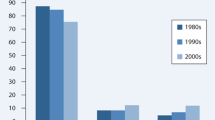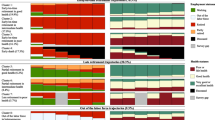Abstract
Extending working lives is often proposed as one route through which the costs associated with population ageing can be managed. In that context, understanding who currently works for longer can help policymakers to design policies to facilitate longer working. In particular, it is important to know if longer working is a choice or a necessity, where necessity arises from a lack of pension income. In this paper, we use data from the first four waves of the Irish Longitudinal Study of Ageing (TILDA), covering the period 2010–2016, to examine patterns of employment among men and women aged 65+. We find that a lack of pension income is an important determinant of later-life working and that this applies for both men and women. Although older women are significantly less likely to work than older men, we find few differences in the pattern of determinants of longer working among older men and women. However, while women are significantly less likely to work than men, this effect is stronger among married women compared to single women. This suggests that older women without immediate access to family-provided financial support may need to work to support themselves. This adds to the picture of later life work being a necessity as opposed to a choice. However, an alternative explanation is that older married women may also have caring responsibilities that reduce their labour force participation.


Similar content being viewed by others
Notes
In 2016, the EU-28 average employment rate for 65+ year old men was 8.2% (ranging from 2.4% in Spain to 23.8% in Estonia), while for women the EU-28 average was 3.2% (ranging from 1.2% in Belgium to 26.2% in Estonia). See https://stats.oecd.org/ for details [last accessed 7 December 2017].
This category includes unpaid work in family business, temporarily away from work, or participating in apprenticeship or an employment programme, such as Community Employment.
In TILDA, hours of work are not recorded for the non-farming self-employed.
For those not engaged in farming, the nature of their business or activity is classified according to the NACE Rev. 2 industry classification. Data on NACE sector are not shown in Table 4.
Using data from the CSO Quarterly National Household Survey (QNHS), Redmond et al. (2017) find no effect of the abolition of the state pension (transition) on the probability of retirement among 65-year olds in Ireland.
Boeri and Brugiavini (2008), exploiting a natural experiment in Italy that changed incentives for early retirement found stronger effects of the policy change for men than for women, although the effect for women was dependent on the number and length of ‘gaps in career’.
References
Angrisani, M., Kapteyn, A., & Meijer, E. (2015). Nonmonetary job characteristics and employment transitions at older ages. Working Paper 2015–326. University of Michigan: University of Michigan Retirement Research Center.
Banks, J., Emmerson, C., & Tetlow, G. (2015). Health capacity to work at older ages: Evidence from the United Kingdom. NBER Working Paper No 21980. Washington: NBER.
Barrett, A., Savva, G., Timonen, V., & Kenny, R. (2011). Fifty plus in Ireland 2011. First results from the Irish Longitudinal Study on Ageing (TILDA). Dublin: The Irish longitudinal study on ageing.
Boeri, T., & Brugiavini, A. (2008). Pension reforms and women retirement plans. Journal of Population Ageing, 1(1), 7–30.
Cahill, K., Giandrea, M., & Quinn, J. (2006). Retirement patterns from career employment. The Gerontologist, 46(4), 514–523. https://doi.org/10.1093/geront/46.4.514.
Cahill, K., Giandrea, M., & Quinn, J. (2011). Reentering the labor force after retirement. Monthly Labor Review, 134(6), 34–42 http://www.bls.gov/opub/mlr/#. Accessed 17 Aug 2015.
Chandler, D., & Tetlow, G. (2014a). Employment of older people in England: 2012–2013. IFS Briefing Note BN153. London: Institute for Fiscal Studies.
Chandler, D., & Tetlow, G. (2014b). Retirement in the 21st century. IFS Report R98. London: Institute for Fiscal Studies.
Coile, C., Milligan, K., & Wise, D. (2016). Health capacity to work at older ages: Evidence from the US. NBER Working Paper 21940. Washington: NBER.
Coile, C., Mulligan, K., & Wise, D. (2017). Introduction. In D. Wise (Ed.), Social security programs and retirement around the world: The capacity to work at older ages. Chicago: University of Chicago Press.
Cribb, J., Emmerson, C., & Tetlow, G. (2014). Incentives, shocks or signals: Labour supply effects of increasing the female state pension age in the UK. IFS Working Paper W13/03. London: IFS.
Cronin, H., O'Regan, C., Finucane, C., Kearney, P., & Kenny, R. A. (2013). Health and aging: Development of the Irish longitudinal study on ageing health assessment. Journal of the American Geriatrics Society, 61, S269–S278. https://doi.org/10.1111/jgs.12197.
Department of Public Expenditure and Reform. (2016). Report of the interdepartmental group on fuller working lives. Dublin: Stationery Office.
Donoghue, O., McGarrigle, C., Foley, M., Fagan, A., Meaney, J. & Kenny, R. (2018). Cohort Profile Update: The Irish Longitudinal Study on Ageing (TILDA). International Journal of Epidemiology, 47, 1398–1398l.
Emmerson, C., & Tetlow, G. (2006). Labour market transitions. In J. Banks, E. Breeze, C. Lessof, & J. Nazroo (Eds.), Retirement, health and relationships of the older population in England: The 2004 English longitudinal study on ageing (wave 2). London: Institute for Fiscal Studies.
Fahle, S., & McGarry, K. (2017). Women working longer: The labour market implications of providing family care. In C. Goldin & L. Katz (Eds.), Women working longer: Increased employment at older age. Washington: NBER.
Finch, N. (2014). Why are women more likely than men to extend paid work? The impact of work–family life history. [journal article]. European Journal of Ageing, 11(1), 31–39. https://doi.org/10.1007/s10433-013-0290-8.
French, E., & Jones, J. (2017). Health, health insurance, and retirement: A survey. Annual Review of Economics, 9(1), 383–409. https://doi.org/10.1146/annurev-economics-063016-103616.
Goldin, C., & Katz, L. (2017). Women working longer: Some facts and explanations. In C. Goldin & L. Katz (Eds.), Women working longer: Increased employment at older ages. Washington: NBER.
Government of Ireland. (2010). National Pensions Framework. Dublin: Stationery Office.
Gustman, A., & Steinmeier, T. (2004). Social security, pensions and retirement behaviour within the family. Journal of Applied Econometrics, 19(6), 723–737. https://doi.org/10.1002/jae.753.
Hurd, M., & Rohwedder, S. (2011). Trends in labor force participation: How much is due to changes in pensions? [journal article]. Journal of Population Ageing, 4(1), 81–96. https://doi.org/10.1007/s12062-011-9042-8.
Kail, B., & Warner, D. (2013). Leaving retirement: Age-graded relative risks of transitioning Back to work or dying. [journal article]. Population Research and Policy Review, 32(2), 159–182. https://doi.org/10.1007/s11113-012-9256-3.
Kanabar, R. (2015). Post-retirement labour supply in England. The Journal of the Economics of Ageing, 6, 123–132. https://doi.org/10.1016/j.jeoa.2015.05.002.
König, S. (2017). Career histories as determinants of gendered retirement timing in the Danish and Swedish pension systems. [journal article]. European Journal of Ageing, 14(4), 397–406. https://doi.org/10.1007/s10433-017-0424-5.
Lumsdaine, R., & Vermeer, S. (2015). Retirement timing of women and the role of care responsibilities for grandchildren. [journal article]. Demography, 52(2), 433–454. https://doi.org/10.1007/s13524-015-0382-5.
Maestas, N. (2010). Back to work. [article]. Journal of Human Resources, 45(3), 719–748.
Maestas, N. (2017). The return to work and Women's employment decisions. In C. Goldin & L. Katz (Eds.), Women working longer: Increased employment at older age. Washington: NBER.
Maestas, N., & Zissimopoulos, J. (2010). How longer work lives ease the crunch of population aging. Journal of Economic Perspectives, 24(1), 139–160. https://doi.org/10.1257/jep.24.1.139.
McGarrigle, C., Donohue, O., Scarlett, S., & Kenny, R. (2017). Health and wellbeing: Active ageing for older adults in Ireland. Evidence from The Irish Longitudinal Study on Ageing. Dublin: The Irish Longitudinal Study on Ageing.
Nolan, A., Barrett, A. (2019). The Role of Self-Employment in Ireland's Older Workforce. Journal of the Economics of Ageing, https://doi.org/10.1016/j.jeoa.2019.100201.
Nolan, A., O'Regan, C., Dooley, C., Wallace, D., Hever, A., Hudson, E., et al. (2014). The over 50s in a changing Ireland: Economic circumstances, health and well-being. Dublin: The Irish Longitudinal Study on Ageing.
OECD. (2016). Pensions at a glance 2015. Paris: OECD.
Olivetti, C., & Rotz, D. (2017). Changes in marriage and divorce as drivers of employment and retirement of older women. In C. Goldin & L. Katz (Eds.), Women working longer: Increased employment at older ages. Washington: NBER.
Ozawa, M., & Lum, T. (2005). Men who work at age 70 or older. Journal of Gerontological Social Work, 45(4), 41–63. https://doi.org/10.1300/J083v45n04_04.
Pleau, R. (2010). Gender differences in postretirement employment. Research on Aging, 32(3), 267–303. https://doi.org/10.1177/0164027509357706.
Raymo, J., Liang, J., Sugisawa, H., Kobayashi, E., & Sugihara, Y. (2004). Work at older ages in Japan: Variation by gender and employment status. The Journals of Gerontology: Series B, 59(3), S154–S163. https://doi.org/10.1093/geronb/59.3.S154.
Redmond, P., Kelly, E., & McGuinness, S. (2017). Did increasing the state pension age in Ireland affect the overall retirement rate of 65 year olds? . QEC Research Note. Dublin: Economic and Social Research Institute.
Russell, H., & Fahey, T. (2004). Ageing and labour market participation. Dublin: The Equality Authority.
Sonnega, A., Helppie-McFall, B., Hudomiet, P., Willis, R., & Fisher, G. (2018). A comparison of subjective and objective job demands and fit with personal resources as predictors of retirement timing in a National U.S. sample. Work, Aging and Retirement, 4(1), 37–51. https://doi.org/10.1093/workar/wax016.
van Solinge, H. (2014). Who opts for self-employment after retirement? A longitudinal study in the Netherlands. [journal article]. European Journal of Ageing, 11(3), 261–272. https://doi.org/10.1007/s10433-013-0303-7.
von Bonsdorff, M., Zhan, Y., Song, Y., & Wang, M. (2017). Examining bridge employment from a self-employment perspective - evidence from the health and retirement study. Work, Aging and Retirement, 3(3), 298–312. https://doi.org/10.1093/workar/wax012.
Wahrendorf, M., Akinwale, B., Landy, R., Matthews, K., & Blane, D. (2016). Who in Europe works beyond the state pension age and under which conditions? Results from SHARE. [journal article]. Journal of Population Ageing, 10, 269–285. https://doi.org/10.1007/s12062-016-9160-4.
Weir, D. (Ed.). (2017). Aging in the 21st century: Challenges and opportunities for Americans. The Health and Retirement Study. Michigan: University of Michigan.
Whelan, B. J., & Savva, G. M. (2013). Design and methodology of the Irish longitudinal study on ageing. Journal of the American Geriatrics Society, 61, S265–S268. https://doi.org/10.1111/jgs.12199.
Wise, D. (2012). Investigations in the economics of aging. Chicago: University of Chicago Press.
Acknowledgements
This research was funded under the ESRI/Pensions Authority Research Programme ‘TILDA and the Financial Dimensions of Retirement’. The authors thank The Irish Longitudinal Study on Ageing (TILDA) for access to the data.
Author information
Authors and Affiliations
Corresponding author
Additional information
Publisher’s Note
Springer Nature remains neutral with regard to jurisdictional claims in published maps and institutional affiliations.
Appendix
Appendix
Rights and permissions
About this article
Cite this article
Nolan, A., Barrett, A. Working Beyond age 65 in Ireland. Population Ageing 12, 299–326 (2019). https://doi.org/10.1007/s12062-019-09249-3
Received:
Accepted:
Published:
Issue Date:
DOI: https://doi.org/10.1007/s12062-019-09249-3




